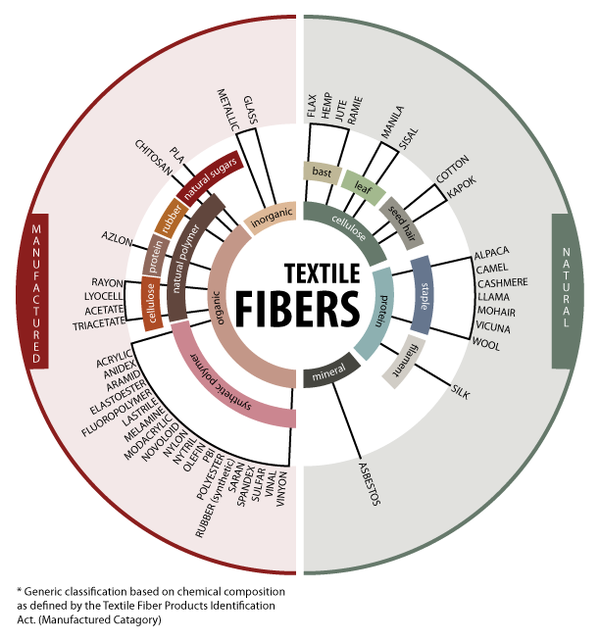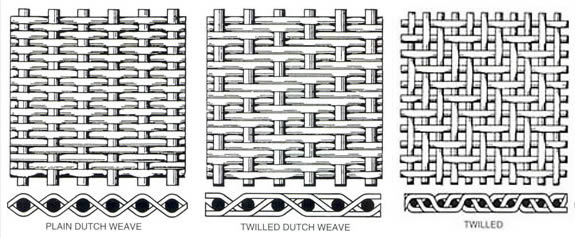The continuing evolution of the textiles industry provides a wide spread of applications from high- performance technical textiles to the more traditional clothing market. More recent developments in this industry require designers to combine traditional textile science and new technologies leading to exciting applications in smart textiles, sportswear, aerospace and other potential areas.
There are many ethical considerations attached to the production of natural fibres.
Raw materials for textiles

Natural fibres
Materials produced by plants or animals that can be spun into a thread, rope or filament.
Common examples include:
- Wool
- Cotton
- Silk
Synthetic fibres
Fibres made from a man-made material that are spun into a thread; the joining of monomers into polymers by the process of polymerisation.
Common examples include:
Acrylic, nylon, polyester, lyrca, rayon, acetate, spandex, and Kevlar
Properties of natural fibres
- Absorbency – is very high
- Strength – low tensile strength
- Elasticity – not very elastic
- Effect of temperature – will burn but does not melt.
NB: Japanese firemen of the past once wore cotton or wool suits to protect them from fires.
Properties of synthetic fibres
- Absorbency – is very low
- Strength – high tensile strength
- Elasticity – highly elastic (like stockings, socks etc)
- Effect of temperature – will burn and melt.
This website has a good table on the source of fibres and their advantages and disadvantages
| Conversion of fibres to yarns |
Conversion of yarns into fabrics |
Conversion of yarns into fabrics:
Weaving
-
The act of forming a sheet like material by interlacing long threads passing in one direction with others at a right angle to them.
| https://www.youtube.com/watch?v=TyhDkd8Iabs |  |
Knitting
-
A method for converting a yarn into fabric by creating consecutive rows of interlocking loops of yarn.
| https://www.youtube.com/watch?v=cch5MuIQKHk |
Lacemaking
-
A method for creating a decorative fabric that is woven into symmetrical patterns and figures.
Felting
-
A method for converting yarn into fabric by matting the fibres together.
Ethical Considerations of the creation of textiles.
There are many ethical considerations attached to the production of natural fibres.
- The strongest natural silk known to man is harvested from silk spiders and notoriously difficult to obtain, and labour intensive.
- In an effort to produce higher yields, scientists have altered the genome of goats so that they produce the same silk proteins in their milk.
- Many textiles are made in developing countries and the work conditions of the labour force is often repetitive, low skilled and in poor conditions. See video below.
https://www.youtube.com/watch?v=hwQgkm0Afqc
Recovery and disposal of textiles
- a great amount of textile waste is produced each that could go to good use or be a new source of revenue stream
- Wikipedia of recycling textiles

Design contexts
Wool
- Clothing – sweaters/jumpers, suits, socks, etc
- Upholstery – couches, chairs etc
- Rugs
- Blankets
- Industrial use – padding, structural insulation, mattresses & futons, oil & hazardous liquids clean up pads, …
Cotton
- Clothing – pants, underwear, T-shirts, etc
- Bedding/furnishings – sheets, covers, pillows …
- Industrial use – wall coverings, book binding tapes, tarpaulins, threads for sewing …
Silk
- Clothing – shirts, under garments, pyjamas, robes …
- Medical sutures (stitches)
- Upholstery & Bedding
Nylon
- Clothing – raincoats, stockings, socks …
- Industrial use – parachutes, tents, tyres, ropes …
Polyester
- Industrial use – seat belts, tents, transportation upholstery, ropes, sails, fish nets,
- Clothing – underwear, night wear and high pile fabrics.
- Furnishings – curtains, drapes, upholstery, carpets and rugs
Lyrca
- Close fitting clothing.
- Sportswear – cycling, running, etc
- Underwear
Smart textiles
- Fibre2Fashion website
- Wikipedia reference
Sportswear
- Smart Textiles in sport
Aerospace
- Textiles in Space article
- Textiles at NASA
International Mindedness
The economics and politics of the production and sale of clothing by multinationals can be a major ethical issue for consumers and the workforce.
Theory of Knowledge
Designers use natural and man-made products. Do some areas of knowledge see an intrinsic difference between these?